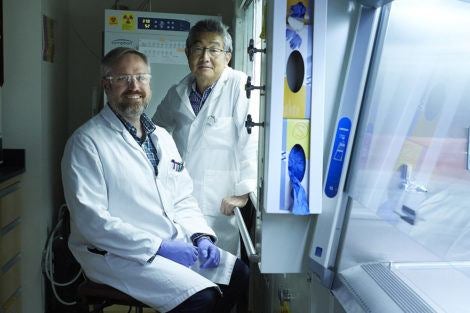Using a rat model, researchers found that newborn lungs may have enhanced susceptibility to inhaled nanoparticles
September 10, 2019—A higher percentage of nanoparticles pass from the lungs to the blood in immature rats than in adult rats, according to a new study led by researchers at the Center for Nanotechnology and Nanotoxicology at Harvard T.H. Chan School of Public Health. It is the first known experimental demonstration of leakier lung tissues allowing more nanoparticles to cross the air-blood barrier early in lung development compared to fully developed adult lungs, and could have important implications for the health of infants and young children.
These tiny particles—less than 100 nanometers (billionths of a meter)—are released into the air in a variety of ways, including by car exhaust and by use of consumer products such as printer inks and household cleaning sprays. Nanoparticles’ size may allow them to penetrate biological barriers, which could trigger adverse health effects.
“We do not know whether the lungs of human babies are more permeable to inhaled nanoparticles than adult ones. It is essential to ask and answer the question experimentally in animal models that share important developmental features in their biology with that of humans,” said lead author Akira Tsuda, principal research scientist in the Department of Environmental Health. “We believe that our study is a significant step in the field of nanoparticle research.”
The findings were published online August 9, 2019 in ACS Nano.
For the study, researchers used a rat model of postnatal lung development: 3-days-old rats, equivalent to human preterm babies; 7-days-old rats, equivalent to human newborns; and 21-days-old rats, equivalent to human toddlers. Engineered gold nanoparticles, which are toxicologically inert, insoluble, and easy to measure in biological samples, were delivered to the lungs through a tracheal tube and then after three hours measured in the lungs and other tissues.
The researchers found that the amount of nanoparticles that moved from the lungs to the blood of the infant rats was significantly higher than what had been seen in previous studies of mature rats, and progressively decreased with age: 23% at 3-days-old; 6% at 7-days-old; 3% at 21-days-old. In a mature rat more than 90 days old, studies had found that less than 1% of nanoparticles permeate the air-blood barrier.
According to Tsuda, more research is needed to understand whether human infants have enhanced susceptibility to inhaled nanoparticles, and what implications this may have for indoor and outdoor air pollution standards.
At the same time, nanoparticles have potential applications in medicine for improving children’s health, Tsuda said. For example, inhaled aerosol mists could provide a non-invasive, lower-cost way to deliver vaccines.
Other Harvard Chan School authors included Thomas Donaghey, Nagarjun Konduru, Georgios Pyrgiotakis, Zhenyuan Zhang, Joseph Brain, and Philip Demokritou.
Photo: Kent Dayton
